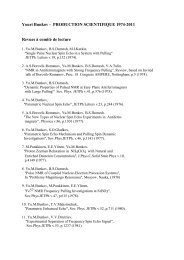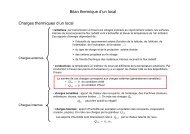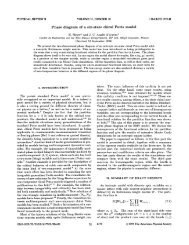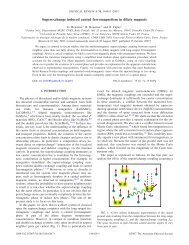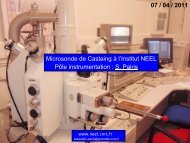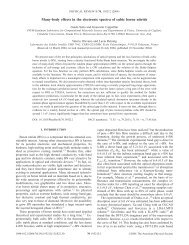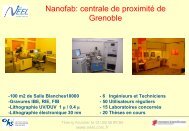Activity Report 2010 - CNRS
Activity Report 2010 - CNRS
Activity Report 2010 - CNRS
You also want an ePaper? Increase the reach of your titles
YUMPU automatically turns print PDFs into web optimized ePapers that Google loves.
SCIENTIFIC REPORT<br />
FURTHER READING<br />
Nature 464, 1174-1177 (<strong>2010</strong>)<br />
Substrate-enhanced supercooling in<br />
AuSi eutectic droplets<br />
Astronomy and Astrophysics, 521, id.<br />
A29 (<strong>2010</strong>)<br />
NIKA: A millimeter-wave kinetic<br />
inductance camera<br />
In situ X-ray investigation<br />
of growing semiconductor<br />
nanowires<br />
“New comers” Project 2007: Tobias<br />
SCHÜLLI (ESRF & French CRG)<br />
Post-doctoral Fellow: Valentina CANTELLI<br />
Supercooled liquids are trapped in a<br />
metastable state even well below their<br />
freezing point, which can only be<br />
achieved in liquids that do not contain<br />
seeds that may trigger crystallization. It<br />
was during their studies, focused on the<br />
growth of semiconducting nanowires,<br />
that T. Schülli et al. discovered the<br />
unusual properties of a gold-silicon alloy,<br />
in contact with silicon (111) surface.<br />
(Fig.2)<br />
As they were observing the first stage of<br />
growth of nanowires, they saw that the<br />
metal-semiconductor alloy they used<br />
remained liquid at a much lower<br />
temperature than its crystallization point.<br />
The team studied what happened to the<br />
liquid in contact with a five-fold<br />
coordinated surface and then performed<br />
the control experiment with the same<br />
liquid exposed to three-fold and four-fold<br />
coordinated surfaces, which reduced the<br />
supercooling effect dramatically. This<br />
constituted the first experimental proof<br />
that pentagonal order is at the origin of<br />
supercooling.<br />
the solid–liquid interaction for the<br />
structure of the adjacent liquid layers.<br />
Such processes are crucial for present<br />
and future technologies, as fluidity and<br />
crystallization play a key part in soldering<br />
and casting, as well as in processing and<br />
controlling chemical reactions for<br />
microfluidic devices or during the<br />
vapour–liquid–solid growth of<br />
semiconductor nanowires.<br />
New generation of nanodetectors<br />
for astrophysics<br />
“New comers” Project 2007: Alessandro<br />
MONFARDINI (Institut Néel)<br />
Post-doctoral Fellow: Loren SWENSON<br />
The Néel IRAM KIDs Arrays (NIKA)<br />
project was kicked off in November 2008<br />
to develop a large mm-wave resident<br />
instrument at the 30-m IRAM<br />
radiotelescope on the Pico Veleta, near<br />
Granada (Spain). The main competitor to<br />
achieve this goal at IRAM is the GISMO<br />
collaboration led by the NASA Goddard<br />
Space Flight Center, focusing on<br />
superconducting TES (Transition Edge<br />
Sensors).<br />
An excellent post-doc (Loren SWENSON)<br />
was hired in July 2008 coming from Dr.<br />
Cleland’s famous group at the University<br />
of California Santa Barbara. A new<br />
dilution cryostat was developed, adapted<br />
for KIDs testing, when also started the<br />
designing/fabricating/testing of the first<br />
NbN resonators in collaboration with<br />
INAC (J.C. Villegier) and Olivier Buisson<br />
at the Institut Néel.<br />
In 2009, beginned the investigation of a<br />
particular KID concept known as LEKID<br />
(Lumped Element KID), allowing a purely<br />
planar design and a good optical<br />
coupling. Totally unexplored at that time,<br />
the potential of this new configuration for<br />
future large instruments operating in the<br />
mm-wave range was well appreciated.<br />
24<br />
Fig. 2: Droplet of a gold-silicon liquid alloy on<br />
a silicon (111) surface. Pentagonal clusters<br />
formed at the interface exhibit a denser<br />
structure compared to solid gold and prevent<br />
the liquid from crystallization at temperatures<br />
as low as 300 Kelvin below the solidification<br />
temperature. Graphics: M. Collignon<br />
It was therefore revealed that pentagonal<br />
atomic arrangements of Au atoms at this<br />
interface favour a lateral-ordering<br />
stabilization process of the liquid phase.<br />
This interface-enhanced stabilization of<br />
the liquid state shows the importance of<br />
Thanks to the rapid development of the<br />
project, a request for one week technical<br />
time at the 30-m telescope was made in<br />
September 2009. (To better understand<br />
the amplitude of the project, the<br />
approximate cost of one single hour time<br />
at Pico Veleta is estimated 1 k€.)<br />
The first run took place in October 2009,<br />
with very encouraging results. One could<br />
observe, for example, a number of faint<br />
galactic and extra-galactic sources.<br />
This LEKID array, used at the telescope,<br />
had been fabricated at the PTA-Grenoble<br />
platform.<br />
After the first light, and despite the small<br />
number of pixels (30-40) NIKA was<br />
already exhibiting better performances



